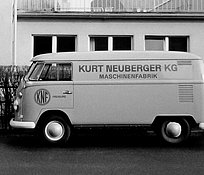
Fuel Cells: Driving the Future of Transportation
Fossil and nuclear fuel reserves are becoming more and more limited. In the future, we will need to increasingly turn to renewable alternatives to meet energy needs in a sustainable manner. Therefore, it is important to take a closer look at what resources we have now which we can draw from in the long run. The European and Asian markets are rapidly developing electricity storage and power supply solutions which rely on battery- and hydrogen-based technology. Hybrid systems with batteries and fuel cells are considered to be one of the best solutions for future-ready, environmentally friendly energy storage and power supply in mobile and stationary applications.
In this article, you will learn how KNF diaphragm pumps are already contributing to this long-term power generation goal and where the future potential of fuel cells lies.
Definition and benefits
Hydrogen fuel cells are galvanic cells that combine hydrogen and oxygen in a chemical reaction which yields electrical energy and only releases water and heat as byproducts. These cells are often compared to batteries, but they do not share the same weaknesses. Batteries rely on previously stored energy and need to be charged, stored, and exchanged regularly, which results in downtime and reduced productivity for manufacturers and users. Fuel cells generate energy and can be refueled quickly. Battery disposal is also a source of environmental concern. Hydrogen fuel cells produce no carbon footprint and offer environmentally conscious users a unique opportunity for energy independence.
Fuel cells in action
Modern mega power plants convert natural gas into electricity and heat on a large scale. Powerful heat and power plants are used, for example, to recycle biogas from agricultural and industrial waste. But gas can also be converted into electricity and heat on a smaller scale. For this purpose, fuel cell technology offers great potential.
Since they can be used to power anything from laptop computers to passenger vehicles to buildings, hydrogen fuel cell systems can operate extremely efficiently at any size. When combined with power generation, some such systems can achieve overall efficiencies of 80% or more. Fuel cell systems combined with hydrogen production and storage can be used to fuel vehicles or to provide communities with electricity. These systems not only provide an economical source of power, but also a unique opportunity for energy independence with zero carbon emissions.
Increasing global interest
Although Europe is not considered to be the driving force of the fuel cell market, exemplified by the mere 100 fuel cell devices in Switzerland and several thousand in Germany, the market has great potential. First and foremost, the Joint Initiative for Hydrogen Vehicles is committed to projects that are predicted to have a lasting impact on fuel cell demand in the transportation sector. The initiative is seeking to deploy 139 new emission-free fuel cell buses in five European countries by 2020 and to adapt refueling infrastructures accordingly.
In the US, the hydrogen road map is focused on the industry sectors of transportation, stationary applications, and portable applications, with the greatest emphasis on transportation. Although interest in fuel cell technology is growing across the globe, the greatest immediate potential lies in the Asia-Pacific region.
Asia opts for fuel cells
Local authorities in countries such as China, Japan and South Korea have launched incentive programs to encourage the use of clean energy.
Although only 5000 hydrogen vehicles are currently being driven on China’s roads, the government has decided to support the hydrogen industry with up to 17 billion dollars – money which was previously intended for subsidizing battery electric vehicles (BEVs). China sees the potential of fuel cell technology, especially in heavy-duty vehicles. Current battery electric power technology is not efficient enough for these trucks, as the batteries powering these large vehicles weigh several tons and take a long time to recharge only to last for a few hundred kilometers.
China is not the only Asian country with great potential for the fuel cell market. It is also predicted that Japan and South Korea will play a major role. The worldwide phase-out of BEV incentives and the introduction of government subsidies for fuel cell electric vehicles in Asia provide promising opportunities for the automotive industry. Coupled with a growing interest in heavy-duty transportation applications in the Asia-Pacific region, the fuel cell component suppliers are also predicted to experience a significant rise in demand.
Pumping the power
KNF is a major player in supplying pumps to manufacturers of PEM fuel cells for use in forklifts, portable devices, transportation vehicles, and power sources. The compact size and minimal power requirements of KNF pumps are essential prerequisites for many gas or liquid transfer applications within fuel cell systems. In PEM fuel cells, KNF diaphragm pumps are used primarily for recirculating pressurized hydrogen gas through a fuel cell stack to maximize electrical power output. Additionally, KNF liquid pumps are used to meter various fuels such as methanol, kerosene, vegetable oil into the fuel cell system. Since pumps are usually the major source of noise in a fuel cell system, KNF provides reliable pumps enhanced with a minimized noise signature and a long service life.
A promising future
It can be expected that changes in consumer behavior will boost demand in the hydrogen and fuel cell markets. The latest research shows that between 2020 and 2025, the global hydrogen and fuel cell market is likely to grow at an annual rate of almost 15%. The number of hydrogen refueling stations (HRSs) is on the rise worldwide and it is assumed that the rapid growth in hydrogen filling stations will drive demand for fuel cell vehicles, further complementing market growth over the forecast period. As fuel cell technology matures, KNF will be there to help power the future.




